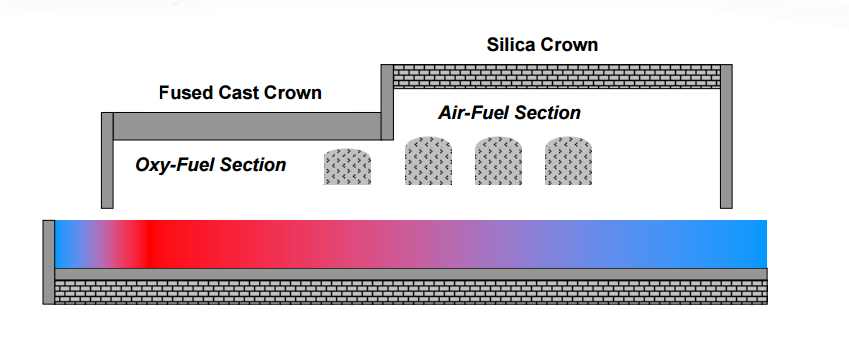
Product List
Success Case
Contact Us
- 0086 371 63838939
- 0086 371 63835539
- sales@sunriserefr.com
- tkfanyi
- No.36 Fengchan Road, Zhengzhou City

News
Refractory Selection for Oxy-Fuel Glass Furnaces
- More related products
- Fused Cast AZS
- Fused Cast Alumina Block
- Fused Cast High Zirconia Block
- Fused Cast Skid Rail Block
Oxy-fuel furnace employs the new oxy-fuel glass melting technology, which can improve glass quality and increase campaign life. The crown, breast wall and sidewall are the key areas of oxy-fuel glass furnaces. The refractory selection of those areas is important.

Oxy-fuel melting involves the replacement of the combustion air with oxygen (>90 % purity). The technique can be used with either natural gas or oil as the fuel, although the use of gas is more common. The technique potentially involves on-site energy savings, because it is not necessary to heat the atmospheric nitrogen to the temperature of the flames. Less combustion air has to be heated and therefore less energy is lost with the furnace waste gases. Besides reducing energy consumption oxy-fuel burning is a very effective method for reducing NOx emissions and dust emission.
One of the disadvantages of oxy-fuel furnaces is the higher alkali vapor which increases refractory wear of silica corrosion at the crown of the furnace. Silica brick is widely used in the crown and superstructure of glass industry. Above 1470℃, it exhibits great corrosion resistance and low bulk density. It is cheap and easy to install. However, when used in oxy-fuel furnaces, it exhibits high resistance to alkali vapor and batch dusts.
Since fused cast refractories are less easily penetrated by vapor phases due to their intrinsically lower open pore volume and have higher corrosion resistance to alkali vapor, fused cast refractories, including fused cast AZS block, alpha-beta and beta fused cast alumina block, can be used as alternatives to silica bricks for the oxy-fuel glass furnace crown. Those refractories perform better than Silica bricks, but are considerably more expensive.
Since the oxy-fuel glass furnaces produce a large amount of water vapor, it increases the concentration of OH- and decreases the viscosity of glass liquid, which increases the convection speed of liquid speed and the wear of the sidewall. AZS block 41# is employed in the sidewall. Its compact crystal structure increases its corrosion resistance and decreases the possibility of pollution to glass liquid.
In the oxy-fuel glass furnaces, the erosion of flame increases the mechanical wear of the breast wall. The attack of hot air causes the flying of alkali components. Some Na2O and K2O attach to the surface of the breast wall and react with the bricks. The alkali vapor attacks into the gaps and open pores of the bricks, which increases the flaking of the bricks. Fused cast refractories are always used in the breast wall.
Sunrise offers all kinds of refractories of high quality for oxy-fuel glass furnaces, including fused cast AZS block, fused cast alumina block, etc..
- Read more
- The Application Of Fused Cast AZS Block In The Sidewall Of Glass Furnaces
- How To Prolong The Service Life Of Glass Furnace
- Forehearth Types And Refractory Selection for The Glass Furnace
- Refractory Selection And Repair Of The Glass Furnace Bottom
- Improvement And Refractory Selection of The Glass Furnace Crown
Leave Message
For more information on any of our products please get in touch using the form below. One of our sales team will respond to your enquiry as soon as possible.

Copyright © 2014 Zhengzhou Sunrise Refractory Co., Ltd. 豫ICP备13002126号












